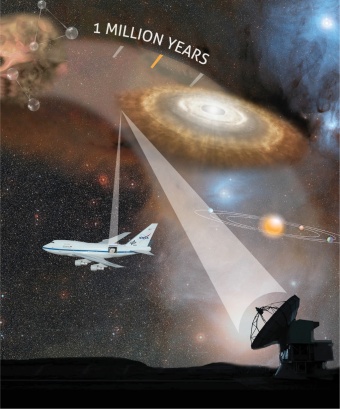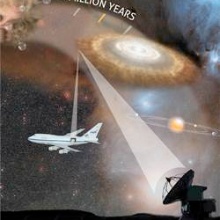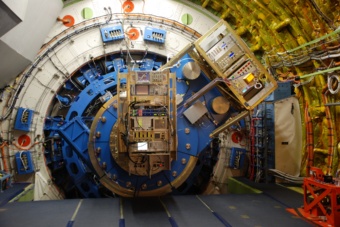-

Our own solar system formed some billion years ago when a dark - interstellar cloud started to contract to form the protostar that later became
the Sun. The duration of this first step in stellar evolution has now been
determined to last at least 1 million years in the similar system IRAS
16293-2422, a collection of protostars ~400 light years away in the
constellation Ophiuchus (background image). This has been achieved by
using molecular hydrogen, H2, as a chemical clock. As hydrogen is not
directly detectable, the chemically closely related species H2D+ has been - observed instead in the far-infrared and sub-millimeter wavelength ranges,
respectively using the airborne observatory SOFIA and the ground-based
telescope APEX in the Chilean Andes. (Figure: Martina Markus &
Oskar Asvany, Credits: NASA/Carla Thomas, C. Durán/ESO/APEX
(MPIfR/ESO/OSO), ESO/Digitized Sky Survey 2/Davide De Martin,
ESO/ L. Calçada, Bill Saxton, NRAO/AUI/NSF)
An international scientific team led by scientists of the Coordinated Research Center (CRC) 956 at the University of Cologne, Germany, applied a new method of age determination to a combination of data from SOFIA and other observatories to make a surprising discovery: The star forming cloud IRAS 16293-2422, located at a distance of about 400 light years in the direction of the constellation Ophiuchus, is at least 1 million years old yet is still making sun-like stars. This is in conflict with current models, which predict star formation should proceed much more rapidly. That result is published in this week’s volume of Nature magazine by researchers from Cologne plus the University of Helsinki and the Max Planck Institutes for Radio Astronomy (MPIfR; Bonn) and Extraterrestrial Physics (MPE; Garching).
Stars like our sun and their planetary systems form from cold and dense interstellar gas and dust clouds that collapse under their own weight. In the first step the material condenses into stellar “embryos” called protostars. Details of how such condensations occur, and on what timescales, are not very well understood. For example, do the clouds “free-fall” toward their respective centers solely under the influence of gravity, or is the collapse significantly slowed by other factors? “Since this process takes much longer than human history, it cannot just be followed as a function of time. Instead, one needs to find an internal clock that allows us to read off the age of a particular star forming cloud,” says lead author Sandra Brünken.
-
The GREAT far-infrared spectrometer onboard SOFIA. The instrument is
shown mounted on the telescope flange inside the pressurized cabin.
© R. Güsten
Here is where SOFIA flies in to help: The molecule H2D+ (a combination or two atoms of ordinary ‘ light’ hydrogen plus one atom of ‘heavy’ hydrogen, deuterium) is enriched in dense and cold star forming regions. The spin axes of the two H atom nuclei within each molecule flip their relative orientations at a known rate. Molecules with one nuclear spin orientation emit and absorb a spectral line at a far-infrared wavelength of 219 microns (1.37 THz, ‘para’ state, anti-parallel spins). Molecules with the opposite spin emit and absorb at a radio wavelength of 0.806 millimeters (372 GHz, ‘ortho’ state, parallel spins). Because Earth’s atmosphere absorbs all far-infrared radiation from celestial sources, the only observatory able to detect the 219-micron line is SOFIA, operating at an altitude of about 14 km, carrying the GREAT (German Receiver for Astronomy at THz Frequencies) spectrometer. Another advantage is that – in contrast to satellites - the newest technology could be implemented on SOFIA on short time scales; until recently, no instrument was available that could detect the critical range of wavelength for this study. Complementary observations of the millimeter-wavelength line were obtained using the ground-based APEX (Atacama Pathfinder EXperiment) telescope located in the Chilean Andes at an altitude of 5100 meters (16,700 feet). In their Nature publication the team around Stephan Schlemmer at the University of Cologne explains why the ratio of the ortho (APEX) to para (SOFIA) states of H2D+ in cold and dense gas clouds allows an accurate age estimation of Sun-like star nursery. Reading this chemical clock for IRAS 16293-2422 yields an age of at least 1 Million years.
“These H2D+ measurements introduce a basic new method for age determinations in cold molecular clouds, with SOFIA’s far infrared spectroscopy capable of playing a major role” , comments Hans Zinnecker from the German SOFIA Institute (DSI) at the University of Stuttgart, who is Deputy Director of SOFIAs Science Mission Operations located at NASA’s Ames Research Center, Moffett Field, Calif. “This underlines the future potential of SOFIA, since at the moment the NASA/DLR airborne observatory is the only one that allows astronomers to detect far infrared radiation from the cosmos.”
Original Publication:
“ H2D+ observations give an age of at least one million years for a cloud core forming Sun-like stars”
Sandra Brünken, Olli Sipilä, Edward T. Chambers, Jorma Harju, Paola Caselli, Oskar Asvany, Cornelia E. Honingh, Tomasz Kamiński, Karl M. Menten, Jürgen Stutzki, Stephan Schlemmer
Further information / links:
- Press release by Universität zu Köln: http://www.portal.uni-koeln.de/nachricht+M5852dfb0e22.html
- Coordinated Research Center (CRC) 956 / Sonderforschungsbereich (SFB) 956: http://www.sfb956.de
- I. Physikalisches Institut der Universität zu Köln: http://www.astro.uni-koeln.de
- Max-Planck-Institut für Radioastronomie: MPIfR Bonn http://www.mpifr-bonn.mpg.de
- Max-Planck-Institut für Extraterrestrische Physik (MPE) Garching: https://www.mpe.mpg.de/index
- University of Helsinki: http://www.helsinki.fi/university
- NASA/SOFIA: http://www.nasa.gov/mission_pages/SOFIA/index.html; and SOFIA Science Center: http://www.sofia.usra.edu
- GREAT instrument webpage: http://www3.mpifr-bonn.mpg.de/div/submmtech/heterodyne/great/greatmain.html
- Deutsches Zentrum für Luft- und Raumfahrt (DLR): http://www.dlr.de/dlr/de
- APEX telescope: http://www.apex-telescope.org
Prof. Stephan Schlemmer
I. Physikalisches Institut
Universität zu Köln
Telefon: +49 (0)221 470 7880
Email: schlemmer@ph1.uni-koeln.de
web: http://www.astro.uni-koeln.de/labastro
Merle Hettesheimer
Presse und Öffentlichkeitsarbeit
Universität zu Köln
Telefon: +49 (0)221 4701700
Email: m.hettesheimer@uni-koeln.de
Dr. Dörte Mehlert
Deutsches SOFIA Institut
Universität Stuttgart
Telefon: +49 (0)711 – 685 69632
Email: mehlert@dsi.uni-stuttgart.de
Background:
GREAT, the German Receiver for Astronomy at Terahertz Frequencies, is a receiver for spectroscopic observations in the far infrared spectral regime at frequencies between 1.25 and 5 terahertz (wavelengths of 60 to 220 microns), which are not accessible from the ground due to absorption by water vapor in the atmosphere. GREAT is a first-generation German SOFIA instrument, developed and maintained by the Max-Planck Institute for Radio Astronomy (MPIfR) and KOSMA at the University of Cologne, in collaboration with the Max Planck Institute for Solar System Research and the DLR Institute of Planetary Research. Rolf Guesten (MPIfR) is the principal investigator for GREAT. The development of the instrument was financed by the participating institutes, the Max Planck Society and the German Research Foundation (Deutsche Forschungsgemeinschaft; DFG).
APEX, the Atacama Pathfinder EXperiment, is a collaboration between the Max Planck Institute for Radio Astronomy (MPIfR), Onsala Space Observatory (OSO), and the European Southern Observatory (ESO) to construct and operate a modified prototype antenna of ALMA (Atacama Large Millimetre Array) as a single dish on the Chajnantor plateau at an altitude of 5,100 meters above sea level (Atacama Desert, Chile). The telescope was manufactured by VERTEX Antennentechnik in Duisburg, Germany. The operation of the telescope is entrusted to ESO.
| Contact | Dörte Mehlert, Email: mehlert@dsi.uni.stuttgart.de; Tel.:0711 - 685-69632 |
|---|



